Samsung QE98Q80C Review
A 98-inch TV with plenty of high performance thrills that doesn't cost as much as you might think
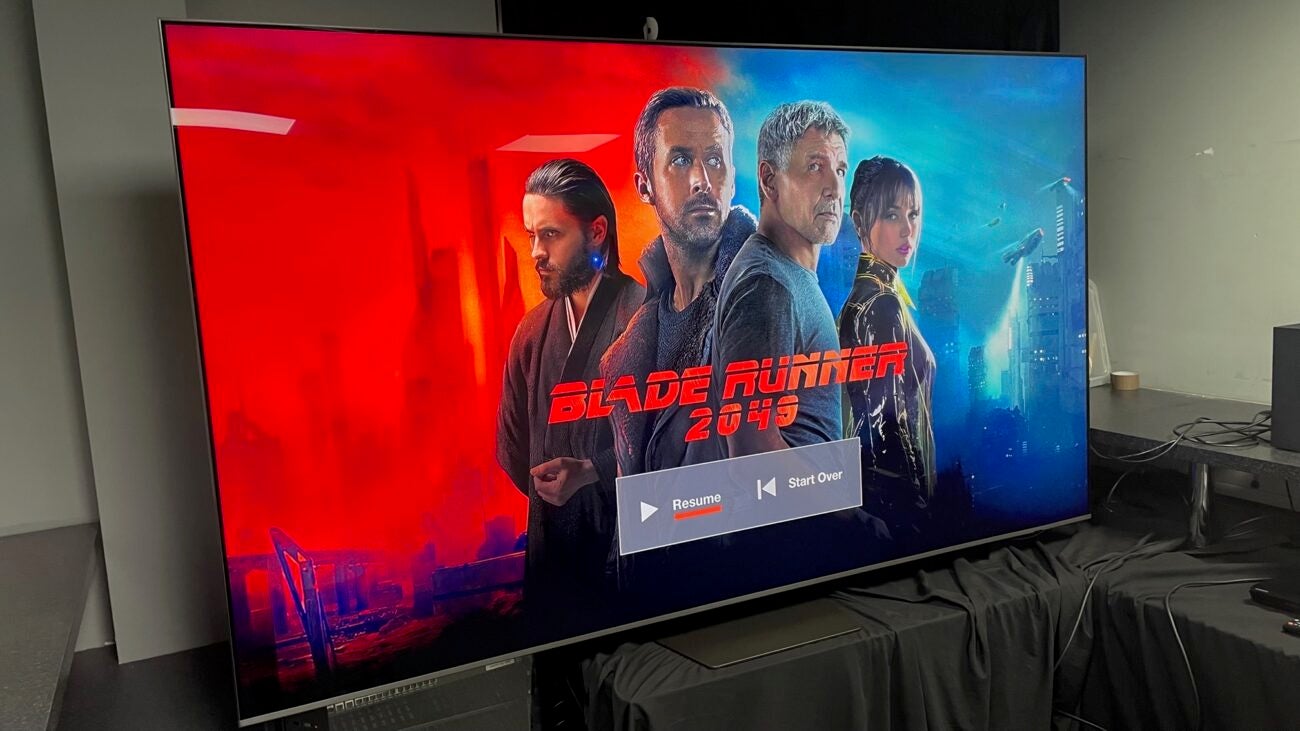



Verdict
Samsung has rewritten the king-sized TV rule book with the QE98Q80C. It combines an epic 98-inch screen with a high quality panel, powerful processing and excellent local dimming light controls to bring a truly cinematic experience to your living room for a previously unthinkably aggressive price.
Pros
- Good price for such a huge and effective TV
- Impressive black levels and local dimming
- Excellent gaming support
Cons
- Blooming becomes visible when viewing off axis
- Sound not as powerful as such a big TV deserves
- No Dolby Vision support
Key Features
- 98-inch screenAt nearly 100-inches wide, this feels more like a cinema than a TV
- Local dimmingUses 120 separately controlled dimming zones to boost contrast
- 4K native resolutionCarries a native 4K resolution of 3840 x 2160 pixels
- Advanced gaming featuresSupports 4K/120Hz graphics, variable refresh rates, and auto game mode switching
Introduction
While truly king-sized TVs weighing in around 100-inches have been around for years, they’ve always belonged in the “if you have to ask, you can’t afford them” territory.
Happily, though, the dream of a cinema-sized TV at home has finally started to become more tangible in recent months, with numerous brands launching king-sized TVs you don’t need an oil well in your garden to afford.
The 98-inch Samsung Q80C is one such relatively affordable monster screen, which delivers a full array with local dimming LED panel and Samsung’s premium 4K processor alongside its sheer enormity for just £4,999.
The only potential downside is that if there’s anything wrong with the QE98Q80C’s pictures, the size of its screen will leave those problems brutally exposed…
Availability
Thanks to the recent arrival of a 98-inch TV from TCL that costs less than £2,500, the QE98Q80C’s £4,999 price no longer looks as eye-catchingly good value as it did before.
The 98Q80C does offer some potentially important upgrades over that ground-breaking TCL – upgrades that have the potential to make a substantial performance difference. Especially with a screen this big, where any strengths – and weaknesses – will inevitably be amplified.
While it’s a significant feature step up from TCL’s entry-level 98-inch TV, the Q80C series actually sits roughly in the middle of Samsung’s latest range. So there are limits to its specification – for instance, it doesn’t get the Mini LED lighting of Samsung’s premium LCD models.
It should be pointed out that while the QE98Q80C is unusually affordable for a such a large mid-range TV, if you’re prepared to sacrifice 13-inches, at the time of review Samsung’s QE85Q80C is £2,399.
The QE98Q80C is widely available across all major AV territories, setting up a big new push of super-sized TVs that Samsung and others are lining up for 2024.
Design
- Surprisingly slim for such a huge screen
- Solar powered remote control
- Ambient Mode
It should be pretty clear to anyone thinking of buying a 98-inch TV that there’s no way it’s going to look subtle, no matter how big a room it’s going in. But surely that’s not the point? The 98Q80C’s ability to completely dominate your view like a cinema screen does is the whole reason you want one, right?
The 98Q80C does take a few steps to at least make sure it doesn’t take over your room more than it has to. So the bezel around the screen is surprisingly narrow considering how much screen acreage it supports, and its rear only sticks out 48.4mm at its deepest point.
Again surprisingly little for a TV that a) carries such a huge screen and b) uses a direct lighting system, where its LEDs sit directly behind the screen rather than around its edges.
The surprisingly slim rear makes the 98Q80C well suited to wall hanging. Provided you’ve got a wall capable of supporting its 56.3kg weight.
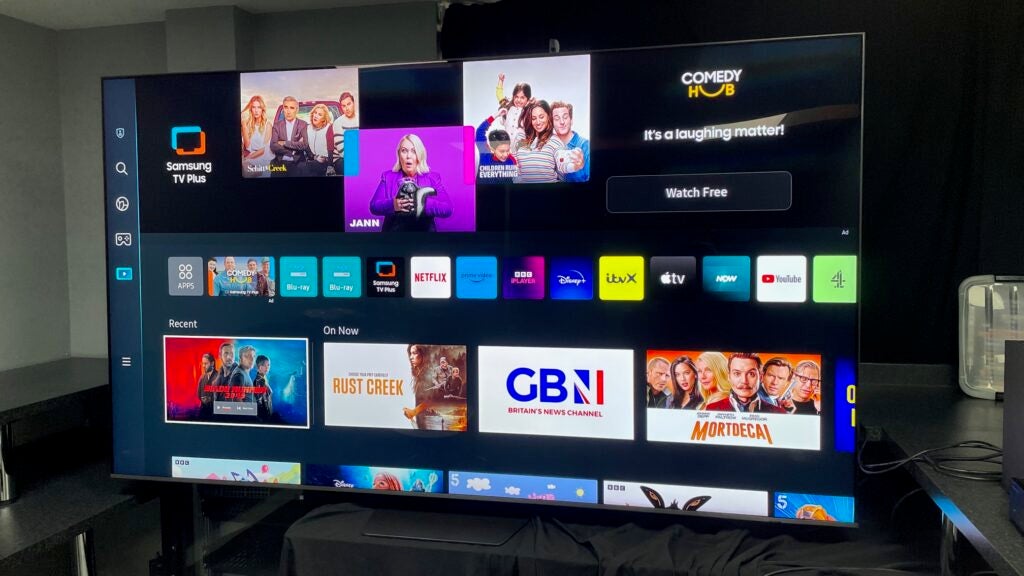
Also particularly welcome is Samsung’s Ambient Mode, where instead of your room being left faced with a gaping black hole when the TV’s off, you can run any of a series of digital artworks or videos (or even your own photos) on the screen in a low-power mode until you’re ready to watch again.
The QE98Q80C ships with two remote controls. The standard one is rather plasticky and button heavy, but still manages to be easy to use. The other smart one is your best bet for day to day use, thanks to its stripped back button count and, best of all, built-in solar panel, meaning you’ll never have to replace its batteries.
Features
- Local dimming using 120 zones
- Quantum Dot colour system
- 4 x HDMI 2.1 ports
The Samsung QE98Q80C giving you a 98-inch screen for £4,999 is far from the only thing it’s got going for it.
Its panel specs are promising for such an affordable TV monster. Its high contrast VA panel is illuminated by a direct LED lighting system, where the LEDs sit behind the screen – a set up that consistently delivers better light control than the alternative approach of placing the LEDs around the edges.
There’s a local dimming system in play too, where contrast is enhanced by different sectors of the lighting system outputting different levels of brightness. As you might expect with the Q80C series mid-range status, it deploys far fewer dimming zones than Samsung’s premium TVs: 120 versus 1344 on Samsung’s flagship QN95C 4K LCD TV. But provided its applied intelligently enough, any dimming can make a massive difference to picture quality.
The intelligence in the 98Q80C comes via Samsung’s Neural Quantum 4K Processor. This is the same processor in Samsung’s flagship TVs, complete with AI and deep learning elements to help the screen recognise and optimise playback of any source thrown at it. The processor has a particularly big part to play in the screen’s upscaling of HD sources. With the screen’s 98-inches, no upscaling or source blemish will remain unseen.
The processor will drive the 98Q80C’s dimming zones – as well as the screen’s Quantum Dot colour system. There’s even an intriguing Supersize Picture Enhancer feature that specially tweaks the noise reduction, sharpness, contrast enhancement, and upscaling processes to achieve pictures better suited to such an epic screen.
Quantum Dot colour systems are capable of delivering wider gamuts and more colour volume than regular LCD colour filters. So it’s good to find the 98Q80C potentially getting good value out of this wide colour volume potential with a peak brightness measurement (on a 10% HDR window) of more than 1000 nits.
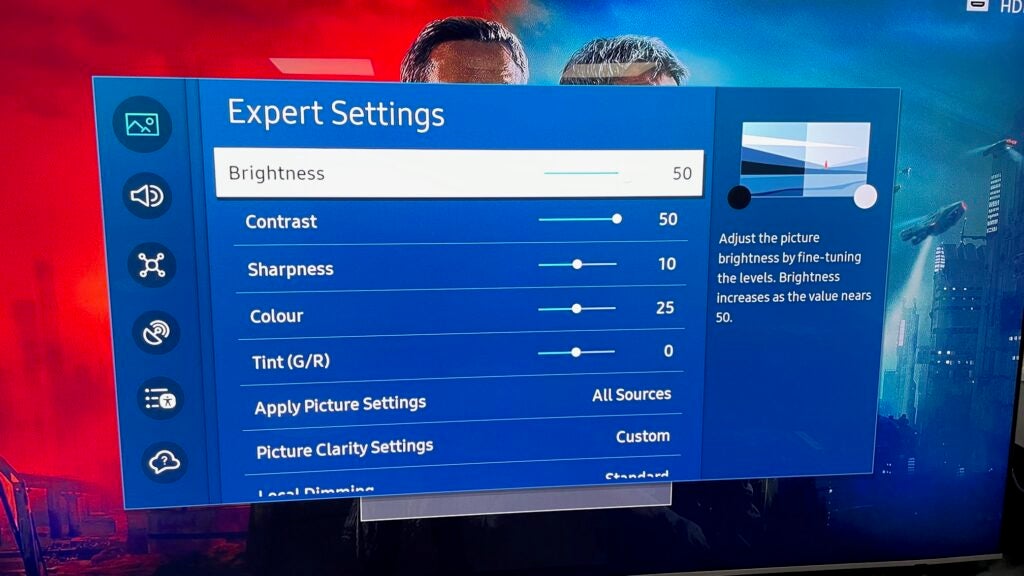
While I can’t help but wonder if Samsung might have been able to push the 98Q80C even brighter had its hands not been tied by the latest EU TV power regulations, a thousand nits is still enough to produce some serious impact. As is the 770 nits the screen remains capable of delivering for full screen brightness. No OLED TV technology can currently get near that level of full screen brightness.
The 98Q80C boasts generous gaming support for a mid-range TV. Its HDMI inputs can all handle 4K/120Hz refresh rates, as well as variable refresh rates (including the AMD FreeSync VRR) and HDMI 2.1’s Auto Low Latency Mode, where the TV automatically goes into its game mode when your console or PC fires up a game.
This fast response mode gets input lag – the time the TV takes to render graphics – down to a seriously nifty 10.7ms. You can opt to sacrifice response speed (lag increases to 27.1ms) for a little motion smoothing if you’re playing a game that doesn’t depend too much on reactions.
This Game Motion Plus mode is accessible along with a few other gaming aids, and information from the gaming signals the TV receives can be viewed via a dedicated Game Bar menu. Plus there’s a Gaming Hub in the 98Q80C’s Tizen interface that brings together gaming sources and game streaming apps into one convenient place.
As with all Samsung TVs, the 98Q80C doesn’t support gaming – or video playback – in Dolby Vision HDR. The only HDR formats it supports are HDR10, HLG and HDR10+.
Wrapping up the 98Q80C’s features is a full version of Samsung’s latest Tizen-based smart system. This is comprehensively packed with apps, with really every catch-up and streaming service present and correct. The only slight pity is there’s no Freeview Play umbrella app for the UK’s terrestrial broadcaster catch up services, though all the services are there individually.
The interface is a little unintuitive in its layout and some of its navigation choices, but it’s an improvement on the 2022 version if you learn your way round its foibles over time.
Picture Quality
- Bright, colourful images
- Good black levels and backlighting
- Blooming only really an issue with off-axis viewing
Far from brutally exposing flaws, the QE98Q80C’s mammoth screen makes it easier to appreciate just how good its picture quality is.
Worries that 120 dimming zones might not be enough to deliver good contrast are rapidly dispelled. Dark scenes actually appear with excellent black levels by LCD TV standards, Even better, this surprisingly inky, greyness-free darkness isn’t spoiled by backlight clouding as I’d feared it might be. You can just about make out a faint bloom of extra light in really extreme circumstances, where a bright white object appears against an almost totally black background, but for the most part Samsung’s dimming zone algorithms are almost uncannily effective.
The 98Q80C doesn’t even have to dim stand-out bright objects anywhere near as much as some of Samsung’s high-end Mini LED TVs do to stop blooming from becoming obvious, creating the sort of consistent viewing experience anyone who buys a 98-inch TV is surely searching for.
One final sign of how intelligently this monster screen is able to distribute its light finds it retaining impressive amounts of shadow detailing in dark scenes. Again, it does this more effectively across all of its picture presets than many TVs that have far more dimming zones at their disposal.
So much so I found myself reflecting that, counter to expectations, using fewer dimming zones might be a good thing for a king-sized screen. Provided that screen is of a good native quality and the processing driving the dimming is up to the job.
Let’s not forget that the 98Q80C delivers its dark scenes so effectively despite being brighter than I’d expected such an affordable big screen to be. With bright HDR highlights not dimmed as strongly as expected, and full-screen bright shots popping off the screen with more than twice as much brightness as on an OLED TV, the 98Q80C delivers a seriously impactful HDR experience. As long as you remember to switch out of its default Eco picture preset.
HDR’s extra light range is intended to help display more life-like images, so having such a convincing stab at it delivered by a screen that can also deliver more life-sized content is a match made in heaven.
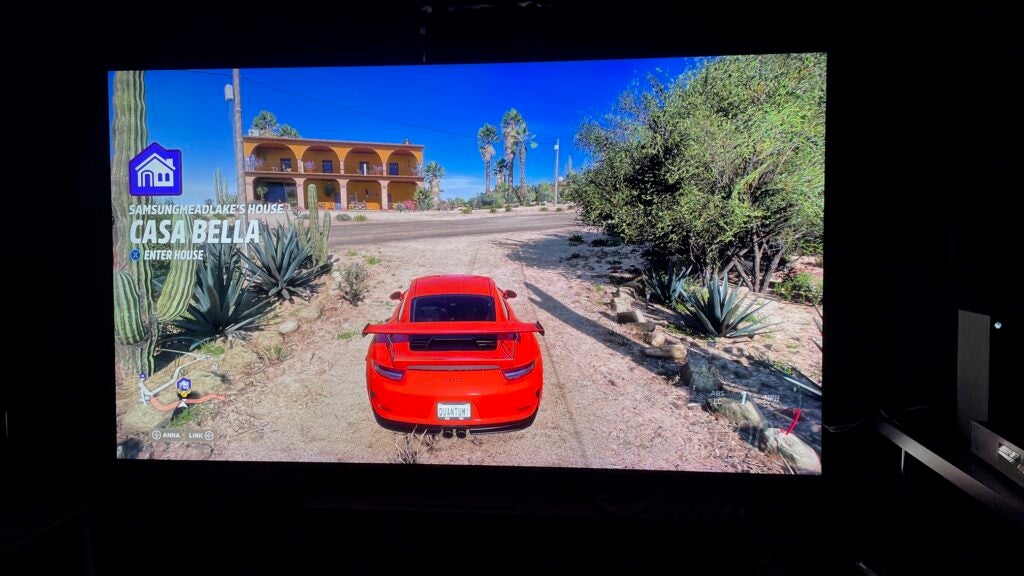
The 98Q80C gets good value out of its Quantum Dot colours too. The screen’s impressive brightness always feels like it’s unlocking more colour volume rather than making colours look thinner and watered down in its brightest areas. The set’s powerful processor ensures there’s plenty of subtle toning and blending in the 98Q80C’s colour rendering too, ensuring that even the most vibrant HDR sources don’t start to look cartoony,
Bright highlights of HDR pictures similarly don’t suffer badly with clipping (lost shading details), and all this persistent detail and subtlety helps the 98Q80C deliver an impressively sharp 4K feel. I’d wondered if I might have felt the need for 8K at the 98-inch screen level, but the 98Q80C’s picture talents are enough to make 4K feel more than good enough.
This is especially true with native 4K images, which I’d suggest you feed a TV of this size as often as you can. Its powerful processor also does an effective job of remapping HD sources to its mammoth 4K screen. SD sources stretch the upscaling a bit, but that’s only to be expected.
There are a few reminders that the 98Q80C is a mid-range TV than a flagship model. The Movie and Filmmaker mode presets make backlight blooming more noticeable than the Standard preset. So it’s just as well the Standard preset is generally very engaging. Backlight blooming becomes more noticeable if you have to view the TV from much of an angle too.
Finally, while the Standard picture preset is the one I’d suggest most people stick with for most types of viewing, it can exhibit exaggerated brightness shifting during sudden cuts between dark and light shots; its colours can start to look a bit over-ripe when watching very aggressively mastered HDR sources. And in rare instances very small areas of bright colour can become strangely desaturated by some quirk of the backlight management system.
Don’t let these niggles put you off thinking big with a 98Q80C, though. For the vast majority of the time its pictures are as engaging, vibrant but also subtle as they are massive.
Sound Quality
- Good detailing and vocals
- Sound effects are accurately placed
- Not as loud as such a home cinema beast ideally would be
The QE98Q80C’s sound is more of a mixed bag than its pictures. In the plus column, its speakers don’t tend to distort or drop out even when pushed towards the TV’s maximum volume.
There’s enough quality in the speakers to prevent shrill treble sounds from becoming uncomfortably harsh, and dialogue usually sounds credible and, given how big the screen is, as if it’s coming from the pictures on the screen rather than the speakers below.
Placement effects are generally quite accurately positioned on the 98Q80C’s vast expanse of screen, making the soundstage feels busy and detailed.
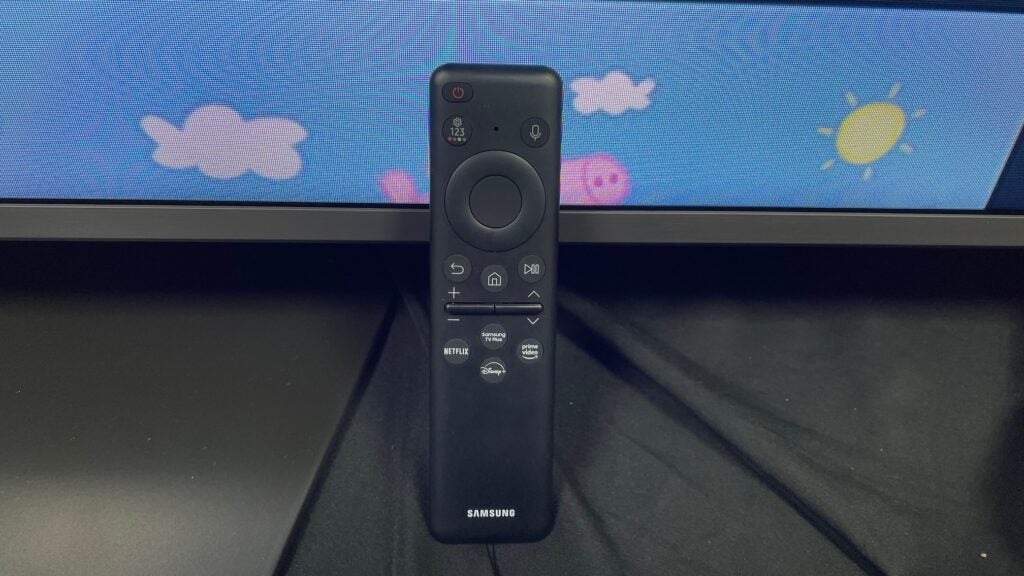
There’s enough low frequency presence to stop action scenes sounding thin or lob-sided – though exceptionally deep, sustained rumbles can cause some unwanted buzzes from the 98Q80C’s massive cabinet from time to time.
The main issue is that the sound doesn’t have the raw power behind it to either reach the epic volume levels or generate the sort of sound stage scale such a screen giant really deserves.
So while it sounds good enough overall to suffice for the short to mid term, you’ll probably want to think about adding a powerful sound system once your bank balance has recovered from the initial £4,999 hit.
Latest deals
Should you buy it?
You want a gigantic, home cinema-sized screen that doesn’t cost the earth
Projector-sized images combined with the brightness, colour and contrast only a high quality TV screen can deliver at much lower price than you’d probably expected.
You can get Samsung’s 85-inch version of this TV for much less
While cheap by 98-inch TV standards, £4,999 is still a chunk of change when you can get the 85-inch version for well under half the price.
Final Thoughts
While the Samsung QE98Q80C faces stiff competition from one or two similarly epic rivals (especially TCL) and, arguably, its own much cheaper 85-inch sibling, if you really want a projector-sized image but with the HDR brightness and contrast only good TVs can deliver, the 98Q80C is nothing short of a colossus.
How we test
We test every television we review thoroughly over an extended period of time. We use industry standard tests to compare features properly. We’ll always tell you what we find. We never, ever, accept money to review a product.
Find out more about how we test in our ethics policy.
Tested at Samsung facility
Tested with real world use
FAQs
A FALD TV is one which, like the Samsung QE98Q80C, uses lighting positioned directly behind the screen and can control specific areas or zones of those lights independently of each other for any given shot, to improve contrast.
Quantum Dots are tiny dots used by some TVs to create colour, using the fact that different size dots produce different wavelengths and, therefore, different colours. This approach can deliver more colour volumes and a wider colour gamut than normal colour filters.
Tizen is the home grown operating system Samsung uses on all of its Smart TVs these days.







